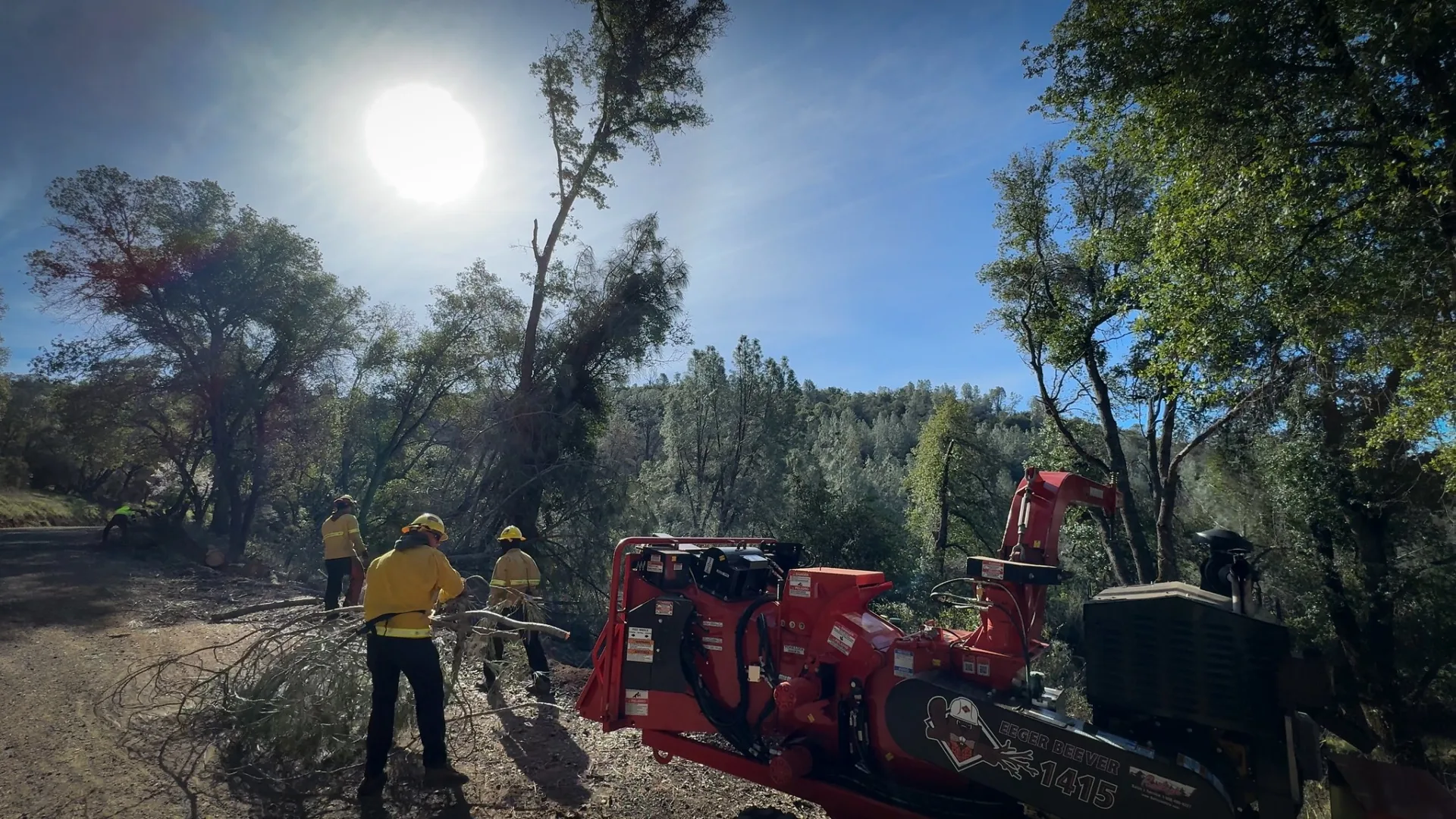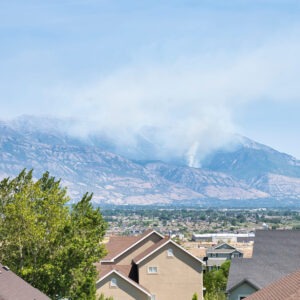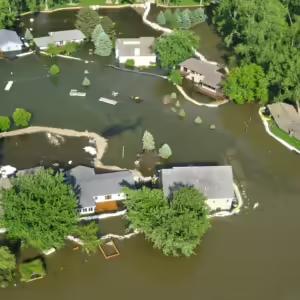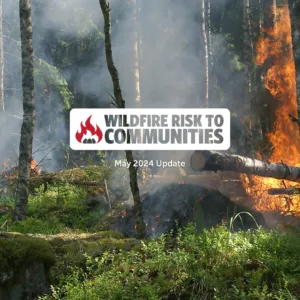As wildfires affect an increasing number of communities, a new U.S. Forest Service program is showing early signs of successfully helping communities access wildfire risk reduction resources. The Community Wildfire Defense Grant (CWDG) program, which features a streamlined application process and targeted technical assistance, has been especially beneficial for low-capacity communities that historically face barriers when competing for federal grants. The program employed several strategies to ensure that rural communities and others with limited staff and financial resources could develop successful applications despite their constraints.
Building on a previous analysis from the first round of CWDG funding, Headwaters Economics conducted an updated independent analysis of the first two rounds of CWDG awards, finding that the program is succeeding in getting federal assistance to communities that are both at risk and in need. Whereas other disaster risk reduction programs have failed to award grants to low-capacity places—those with limited resources—CWDG awards are benefiting a more diverse set of communities. To date, 34% of CWDG funds have reached low-capacity communities compared to only 4% of funds from FEMA’s Building Resilient Infrastructure and Communities (BRIC) program, which has a more typical and onerous federal application process.
What is the Community Wildfire Defense Grant program?
The Community Wildfire Defense Grant program is a competitive program administered by the U.S. Forest Service to help at-risk communities plan for and reduce wildfire risk. In 2021, Congress allocated $1 billion to create the program in the Bipartisan Infrastructure Law. It funds activities on non-federal land such as Community Wildfire Protection Plan development, training and equipment purchasing, home assessments, vegetation management (including prescribed fires and creating defensible space), and staffing that improves wildfire resilience. Local governments, Tribes, nonprofits, and state agencies are eligible to apply. The first two rounds of funding have awarded a total of $420.5 million in grants. The program is in high demand, having received more than 900 applications exceeding $1.5 billion in requested funds to date.
The following analysis describes outcomes from the first two rounds of CWDG awards and the strategies that have helped low-capacity communities gain access. The program’s design holds promise for other federal agencies striving to improve the reach and impact of disaster risk reduction grants.
CWDG is reaching high-risk, low-income communities
Headwaters Economics’ analysis of the first two rounds of CWDG awards shows that grants have been consistently awarded to communities with both high wildfire risk and low-income. For example, we found that 95% of funds were awarded to applicants in counties with either high or very high wildfire risk according to rankings from the U.S. Forest Service’s Wildfire Risk to Communities website. We also found that 99% of funds were awarded to low-income communities, according to the income status levels reported by applicants.
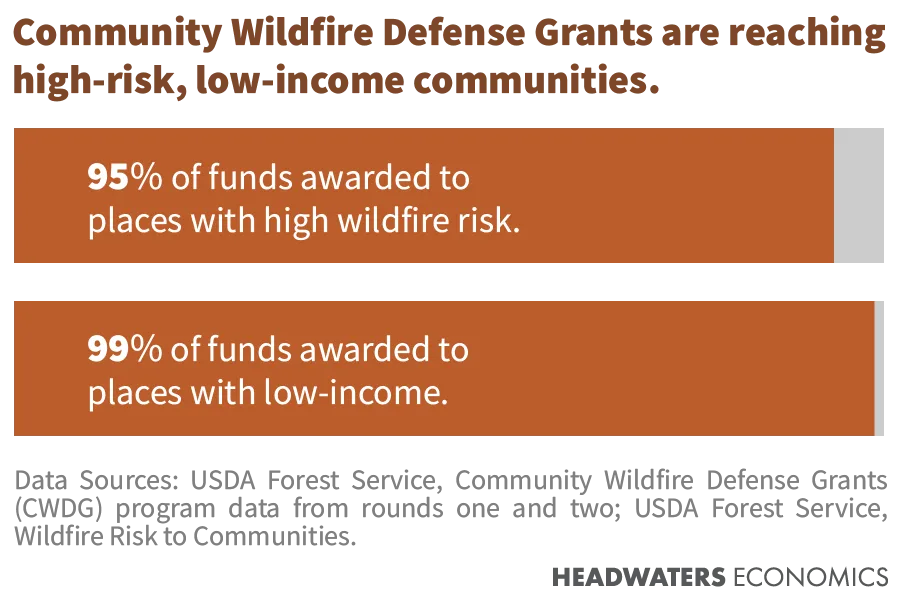
The U.S. Forest Service categorizes proposals as either Community Wildfire Protection Plan (CWPP) Applications, which focus on planning and prioritization for fire departments, forest managers and local officials tasked with reducing wildfire risk in their communities; or Project Applications that focus on implementation, which may include a wide range of mitigation actions such as fuels reduction projects, equipment purchases, and more. To date, the program has awarded funds for the development of more than 145 CWPPs and 112 risk-reduction projects. The financial support for CWPP development is particularly critical for rural and resource-limited communities since federal land management agencies prioritize projects formally identified in CWPPs. The second round of CWDG funding prioritized CWPP applications.
The table below summarizes CWDG applications and awards across both rounds one and two.
CWDG Applications and Awards in Rounds 1 & 2
| Measure | CWPP Applications | Project Applications | Total | |
| Number | Awarded | 145 | 112 | 257 |
| Applied | 402 | 547 | 949 | |
| % Awarded | 36% | 20% | 27% | |
| Dollar amount | Awarded | $25,371,562 | $395,148,200 | $420,519,762 |
| Applied | $65,163,300 | $1,476,663,002 | $1,541,826,302 | |
| % Awarded | 39% | 27% | 27% | |
CWDG is reaching communities with limited resources
Across the country, low-capacity communities have greater exposure to wildfires. Nearly 60% of the 9,100 communities with high wildfire risk also face resource constraints. Many of these communities—which rank below the national median of the Rural Capacity Index—lack the resources needed to plan and implement wildfire mitigation projects. For these communities, grant funding enables them to plan and implement risk reduction projects that would not otherwise be possible.
What is the Rural Capacity Index?
The Rural Capacity Index, created with support from NOAA, identifies communities where investments are needed to support infrastructure and climate adaptation projects. The index includes indicators of capacity grouped into four categories:
- Local government staff and expertise
- Institutional capacity
- Economic opportunity
- Education and engagement
A community’s capacity is measured in terms of the national percentile rank where “low capacity” is defined as a national percentile of <33%, “medium capacity” as 33-66%, and “high capacity” as >66%.
Our analysis shows that the CWDG program has successfully reached communities with low Rural Capacity Index scores—those that frequently struggle to develop competitive federal grant applications due to staffing and resource limitations. In the first two rounds of CWDG, low-capacity communities secured 67 of the 257 successful grant awards and $143 million of the $421 million total awarded funds. Together, low- and medium-capacity communities make up two-thirds of successful applicants and have secured three-quarters of the total awarded funds to date.
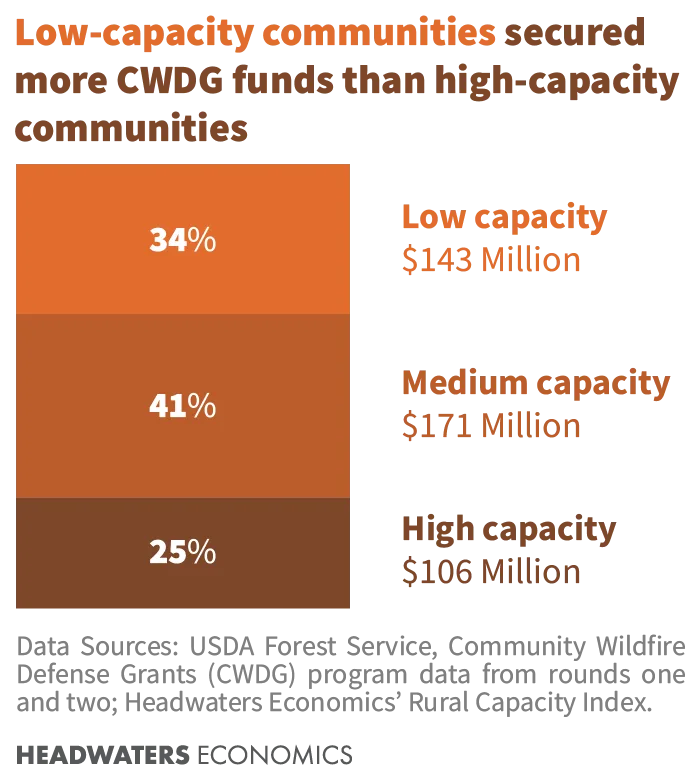
The CWDG program is designed to improve access
The U.S. Forest Service, at the direction of Congress, designed the CWDG program to improve grant access for communities with high wildfire risk and limited resources. The Forest Service deployed three data-driven strategies to improve CWDG grant access:
Strategy 1: Data-informed technical assistance
The U.S. Department of Agriculture established Community Navigators to help rural communities, Tribes, and other groups overcome resource obstacles to accessing grants and agency services. To improve access to CWDG grants, the Navigators—which include nonprofit organizations and Forest Service employees—were provided data for every county, Tribe, and community in the nation to inform their outreach efforts. The data included summaries of each location’s eligibility for CWDG grants, whether previous CWDG applications had been submitted, and measures of local capacity constraints. Community Navigators were able to use this information to prioritize outreach and technical assistance. This strategy helped overcome one of the obstacles that prevents communities from accessing federal programs—the lack of awareness of available grant opportunities.
Strategy 2: Comprehensive eligibility and scoring criteria
Larger communities can often access more robust data that gives them a competitive advantage. To ensure that data constraints did not interfere with the application process, the Forest Service based CWDG eligibility and scoring criteria on comprehensive, national data available for every jurisdiction, including:
Wildfire risk criteria: Applicants were encouraged to make their case using data from the free, nationally available Wildfire Risk to Communities website. Four data options show their community as having high wildfire risk to homes or high wildfire hazard potential, as compared to either their state or the nation. Alternatively, applicants could use state, local, or other data to demonstrate wildfire risk. This strategy ensured that all jurisdictions had access to wildfire risk data, not just higher-capacity locations with customized data.
Low-income criteria: “Low income” was defined as having a median household income less than 80% of the state’s or nation’s median household income, whichever is higher. As opposed to relying on only generalized county-level data, applicants were encouraged to use income data for their specific town or Tribal community. This approach aided communities with limited resources, even if they were located within a more affluent county.
Cost-share waiver criteria: Applicants were able to demonstrate their eligibility for the waived cost-sharing requirement based on either: (a) having at least one census tract identified as “disadvantaged” in the Climate and Economic Justice Screening Tool, or (b) meeting the low-income definition—having a median household income less than 80% of the state’s or nation’s median household income, whichever is higher. Nationally recognized Tribes and Pacific Islands are also eligible for a match waiver.
Commensurate scoring rubrics: The Forest Service developed and applied two scoring rubrics—one for planning applications and another for project implementation proposals. This method of scoring applications helped low-capacity communities secure support for the critical initial stages of risk reduction: planning and prioritization.
Strategy 3: Innovative technology for grant-writing support
One novel strategy deployed by the Forest Service to improve access to CWDG was the development of a grant writing assistance tool. The Community Wildfire Defense Grant (CWDG) Data Dashboard helped communities complete grant proposals and served as an unbiased resource for reviewers to score applications.
The tool, which the Forest Service plans to update and maintain throughout future CWDG grant cycles, provides information needed to answer questions in the application. It pulls in data from publicly available, federal sources, including Wildfire Risk to Communities, the U.S. Census Bureau, and FEMA, and shows whether a community is eligible to apply and which scoring criteria are met.
The Dashboard was released in 2023, in time for applicants to use for the second round of CWDG funding. Along with the tool’s release, the number of applications from low-capacity communities increased by 61% (from 75 to 121). In the round two applications, 85% referenced the CWDG Data Dashboard. The tool has helped level the playing field, enabling rural and lower-capacity communities to successfully compete against jurisdictions that have dedicated grant writing staff.
New opportunities for federal disaster grant programs
The outcomes from the first two rounds of CWDG awards demonstrate that, by streamlining applications and developing grant-writing support, federal disaster programs can successfully support risk reduction in a broader range of high-risk communities across the nation. The program’s design has ensured that community leaders in rural and low-capacity parts of the country can access resources for planning, constructing, and maintaining projects to decrease risks before disasters happen.
Given the outsized exposure that low-capacity communities have to wildfires and the lack of resources available to protect themselves and recover, it is especially important that federal mitigation programs can be accessed by such places. The CWDG program can serve as a model for improving access to federal grants.
Methods and Data Sources
This analysis used U.S. Forest Service data for Community Wildfire Defense Grants (CWDG) applications from funding rounds 1 and 2. The CWDG Round 1 (FY22) awards were announced on March 21, 2023 and the Round 2 (FY23) awards were announced on May 14, 2024.
The Forest Service data provided the county-level location of each CWDG application. Therefore, the comparison of local capacity among applications was based on county-level Rural Capacity Index percentile ranks. The analysis did not include Puerto Rico or Palau due to the lack of available data from Wildfire Risk to Communities and the Rural Capacity Index.
National wildfire risk data are from the “Risk to Homes” dataset in the Wildfire Risk to Communities project. Applications in counties where the “Risk to Homes” national percentile rank is >70 are considered “high or very high” national wildfire risk.
Low-income data are from each CWDG application, according to the income status levels reported by applicants.
The Rural Capacity Index is from Headwaters Economics, A Rural Capacity Map (2024). The Rural Capacity Index is a measure of whether communities have the staffing and expertise to support infrastructure and climate resilience projects and comprises 10 indicators. Counties are categorized as “low capacity” if their index score ranks in the lower 33% of counties nationwide.
